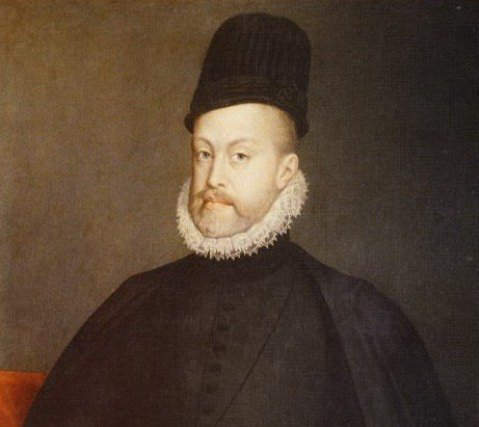La Peregrina - the Pilgrim or Wanderer Pearl
Open FREE Unlimited Store Join Our Newsletter
Please click the following links to read more about two other historic pieces of jewelry from Elizabeth Taylor's legendary jewels collection coming up for auction at the special Christie's Legendary Jewels Evening Sale on December 13, 2011 at the New York Rockefeller Plaza :-
Origin of Name
"La Peregrina" in Spanish means "the Pilgrim" or "the Wanderer." The large pear-shaped white pearl, which originally weighed 223.8 grains, and was the largest pearl ever discovered during this period, was discovered in 1513 off the Pearl Islands in the Gulf of Panama by a negro slave. The pearl entered the Spanish Crown Jewels during the period of rule of King Ferdinand V (1479-1516) or his successor King Charles V (1516-1556). Phillip II (1556-1598) gave the pearl as a gift to Queen Mary I of England (Mary Tudor or Bloody Mary) in anticipation of their marriage in 1554. After Queen Mary's death in 1558 the pearl was returned to Spain, where it remained for over 250 years, becoming a favorite ornament of all queen consorts of Spain until the year 1808, when Napoleon Bonaparte captured Spain and installed his brother Joseph Bonaparte on the throne. When Joseph Bonaparte fled Madrid after the defeat of the French forces by the joint Anglo-Spanish-Portuguese forces at the Battle of Vitoria, he carried the renowned pearl with him. It was then the celebrated pearl came to be known as the "La Peregrina - the Wanderer." Joseph Bonaparte left the pearl to his nephew Charles Louis Napoleon (Napoleon III) who while in exile in London sold it to the 2nd Marques of Abercorn, due to serious financial difficulties. Thus true to its name the "La Peregrina" that arrived from America to Spain, went to England for a short period, then returned to Spain and after remaining in Spain for over 250 years, left for France, from where it went back to England and remained with an aristocratic family, the Dukes of Abercorn until the year 1969, when it was purchased by Richard Burton for his wife Elizabeth Taylor.
Characteristics of the Pearl
The "La Peregrina" one of the largest, nacreous, white, pear-shaped drop pearls in the world
The "La Peregrina" pearl is one of the most famous pearls in the world with a recorded history of nearly 500 years. It is a large pear-shaped white nacreous pearl whose original weight was 223.8 grains (55.95 carats). In 1913 after the pearl was drilled, cleaned, and polished, it had a weight of 203.84 grains. The drilling was necessitated in order to secure it firmly to its setting, as the pearl was nearly lost on three different occasions after it had fallen off from its setting.
The "La Peregrina" pearl was at one time the largest pearl discovered in the world, but until today remains one of the largest pear-shaped pearls ever discovered. Pearls found in nature can be classified into eight basic shapes :- round, semi-round, button, drop, pear, oval, baroque and ringed. The most desired shape of pearls is the perfect round shape, which are also the rarest and the most expensive. Round pearls are used in strings of pearls or necklaces. Drop and pear-shaped pearls, which are also known as tear-drop pearls are often used in earrings, pendants, or as centerpiece of necklaces. During its 500-year history the "La Peregrina" pearl had been variously used as a pendant to a brooch, pendant to a necklace, centerpiece of a necklace, and centerpiece of a hat ornament. Mary I used it as a pendant to a brooch, King Phillip IV of Spain used it as a hat ornament, other queens of Spain used it as a pendant to a necklace or the centerpiece of a necklace.
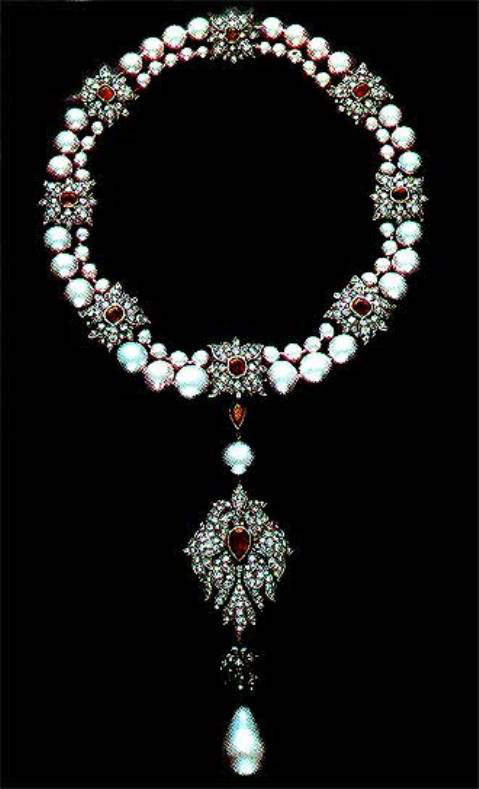
La Peregrina pearl mounted as pendant on a pearl, ruby and diamond necklace designed by Cartier in 1969
Today, the "La Peregrina" owned by Elizabeth Taylor is set as a pendant to a necklace made out of pearls, rubies and diamonds. The necklace was designed by Cartier, after the pearl was purchased by Richard Burton at a Sotheby's auction in 1969. The necklace is a double-stranded pearl necklace interspersed with equally spaced floral patterns eight in number, each having a ruby as its centerpiece, surrounded by diamonds in a floral pattern. The outer strand of pearls is composed of larger drop-shaped pearls, and the inner strand composed of smaller round-shaped pearls. The "La Peregrina" pearl is attached to this necklace as the lower part of an elaborate pendant. The centerpiece of this pendant is a floral design consisting of a central pear-shaped ruby surrounded by diamonds in a floral pattern. The necklace created by Cartier is indeed a masterpiece in its category, and represents the highest standards of jewelry designing for which Cartier has an international reputation.
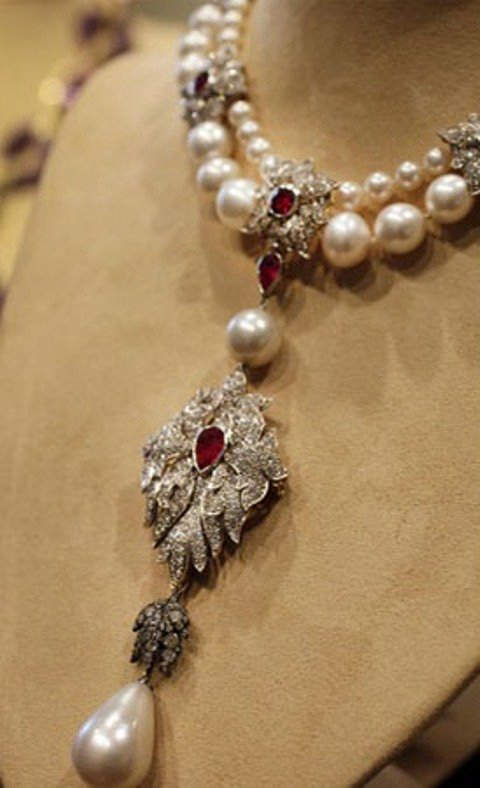
A close-up of the pendant of the La Peregrina Necklace
The position of La Peregrina Pearl in the table of famous nacreous pearls in the world
In the table of famous nacreous pearls arranged in descending order of weights, as given below, the La Peregrina Pearl with the original weight of 223.8 grains, prior to the year 1913, occupied the 15th position. However in 1913 after drilling, cleaning and polishing, the pearl acquired a reduced weight of 203.84 grains, and was pushed to the 16th place on the list.
Table of famous nacreous pearls arranged in descending order of weight
| S/N | Name of Pearl | Weight in Carats and Grains | Shape of Pearl |
Type of Pearl | Color of Pearl |
| 1 | Pearl of Asia | 600 carats, 2,400 grains | Baroque, garden-egg shaped | Saltwater, nacreous pearl | White |
| 2 | Arco-Valley Pearl | 575 carats, 2300 grains | Baroque | Saltwater, nacreous pearl | White |
| 3 | Big Pink Pearl | 470 carats, 1,880 grains | Baroque | Saltwater, nacreous abalone pearl | Pink |
| 4 | Hope Pearl | 450 carats, 1,800 grains | Baroque drop-shaped | Saltwater, nacreous pearl | White |
| 5 | Christopher Walling Abalone Pearl | 187.5 carats, 750 grains | Horn shaped | Saltwater , nacreous pearl | Multi-colored |
| 6 | Imperial Hong Kong Pearl | 127.5 carats, 510 grains | Irregular drop | Saltwater, nacreous pearl | White |
| 7 | Gogibus Pearl | 126 carats, 504 grains | Pear-shaped drop | Saltwater, nacreous pearl | White |
| 8 | Shah Sofi Pearl | 125 carats. 500 grains | Pear-shaped drop | Saltwater, nacreous perl | White |
| 9 | Survival Pearl | 90.35 carats, 361.40 grains | Baroque | Freshwater, nacreous pearl | White |
| 10 | La Regente | 75.67 carats, 302.68 grains | Pear-shaped drop | Saltwater, nacreous pearl | White |
| 11 | Pearl of Kuwait | 64.35 carats, 257.40 grains | Asymmetrical drop-shape | Saltwater, nacreous pearl | White |
| 12 | Paspaley Pearl | 60.94 carats, 243.76 grains | Perfectly spherical | Saltwater, nacreous, cultured pearl | White |
| 13 | Large natural freshwater nacreous pearl, that appeared at Christie's sale 7664 at Dubai | 60.36 carats, 241.44 grains | Near-Spherical | Freshwater nacreous pearl | Yellowish- orange to pinkish-orange |
| 14 | Natural Grey/Brown Pearl | 56.81 carats, 227.24 grains | Symmetrical drop-shape | Saltwater, nacreous pearl | Grey/Brown |
| La Peregrina (Original weight) | 55.95 carats, 223.8 grains | Pear-shaped drop | Saltwater, nacreous pearl | White | |
| 15 | Sara/Tavernier/Shaista Khan Pearl | 55.0 carats, 220 grains | Drop-shaped | Saltwater, nacreous pearl | Gray |
| 16 | La Peregrina after drilling and polishing in 1913 | 50.96 carats, 203.84 grains | Pear-shaped drop | Saltwater, nacreous pearl |
White |
| 17 | Peacock Throne Pearl | 50 carats, 200 grains | Pear-shaped drop | Saltwater nacreous pearl | Yellow |
| 18 | Mancini Pearls | 50 carats, 200 grains. 50 carats, 200 grains | Drop-shaped pearls | Saltwater nacreous | White |
| 19 | Moghul Pearls | 45.5 carats, 182 grains. 45.5 carats, 182 grains | Pear-shaped drop | Saltwater nacreous pearls | White |
| 20 | Drexel Pearl | 33.80 carats, 135.2 grains | Symmetrical drop-shape | Saltwater nacreous pearl | Black Tahitian |
| 21 | La Pelegrina one | 33.29 carats, 133.16 grains | Pear-shaped drop | Saltwater, nacreous pearl | White |
| 22 | Charles II Pearl | 32.5 carats, 130 grains | Pear-shaped drop | Saltwater, nacreous pearl | White |
| 23 | Tararequi Pearls | 31 carats, 124 grains | Pear-shaped drop | Saltwater, nacreous | White |
| 24 | Bapst Pearls | 113.75 grains, 113.25 grains | Perfectly spherical pearls | Saltwater nacreous pearls | White |
| 25 | La Pelegrina two | 27.88 carats, 111.5 grains | Perfectly spherical pearl | Saltwater nacreous pearl | White |
| 26 | La Reine De Pearls | 27.5 carats, 110 grains | Perfectly spherical pearl | Saltwater, nacreous pearl | White |
| 27 | Oviedo Pearl | 26 carats, 104 grains | Perfectly spherical pearl | Saltwater, nacreous | White |
| 28 | Queen/Patterson Pearl | 23.25 carats, 93 grains | Baroque | Freshwater, nacreous pearl | White |
| 29 | Paspaley Drop-shaped Pearls | 18.75 carats, 75 grains. 18.75 carats, 75 grains | Drop-shaped pearls | Saltwater, nacreous pearl | White |
| 30 | Finest black pearl in Europe in 1900 | 12.25 carats, 49 grains | Pear-shaped drop pearl | Saltwater, nacreous pearl | Black pearl with green overtone |
The position of La Peregrina Pearl in the table of famous nacreous drop-shaped pearls in the world
In the table of famous nacreous drop-shaped pearls arranged in descending order of weights, the La Peregrina Pearl occupied the 8th position, when its original weight was 223.8 grains. However, after the pearl acquired its new weight of 203.84 grains as a result of drilling and polishing in 1913, the pearl was pushed to the 9th position on the table.
Table of famous nacreous drop-shaped pearls arranged in descending order of weights
| S/N | Name of Pearl | Weight in Carats and Grains | Shape of Pearl |
Type of Pearl | Color of Pearl |
| 1 | Hope Pearl | 450 carats, 1,800 grains | Baroque drop-shaped | Saltwater, nacreous pearl | White |
| 2 | Imperial Hong Kong Pearl | 127.5 carats, 510 grains | Irregular drop | Saltwater, nacreous pearl | White |
| 3 | Gogibus Pearl | 126 carats, 504 grains | Pear-shaped drop | Saltwater, nacreous pearl | White |
| 4 | Shah Sofi Pearl | 125 carata. 500 graina | Pear-shaped drop | Saltwater, nacreous perl | White |
| 5 | La Regente | 75.67 carats, 302.68 grains | Pear-shaped drop | Saltwater, nacreous pearl | White |
| 6 | Pearl of Kuwait | 64.35 carats, 257.40 grains | Asymmetrical drop-shape | Saltwater, nacreous pearl | White |
| 7 | Natural Grey/Brown Pearl | 56.81 carats, 227.24 grains | Symmetrical drop-shape | Saltwater, nacreous pearl | Grey/Brown |
| La Peregrina (Original weight) | 55.95 carats, 223.8 grains | Pear-shaped drop | Saltwater, nacreous pearl | White | |
| 8 | Sara/Tavernier/Shaista Khan Pearl | 55.0 carats, 220 grains | Drop-shaped | Saltwater, nacreous pearl | Gray |
| 9 | La Peregrina after drilling and polishing in 1913 | 50.96 carats, 203.84 grains | Pear-shaped drop | Saltwater nacreous pearl | White |
| 10 | Peacock Throne Pearl | 50 carats, 200 grains | Pear-shaped drop | Saltwater nacreous pearl | Yellow |
| 11 | Mancini Pearls | 50 carats, 200 grains. 50 carats, 200 grains | Drop-shaped pearls | Saltwater nacreous | White |
| 12 | Moghul Pearls | 45.5 carats, 182 grains. 45.5 carats, 182 grains | Pear-shaped drop | Saltwater nacreous pearls | White |
| 13 | Drexel Pearl | 33.80 carats, 135.2 grains | Symmetrical drop-shape | Saltwater nacreous pearl | Black Tahitian |
| 14 | La Pelegrina one | 33.29 carats, 133.16 grains | Pear-shaped drop | Saltwater, nacreous pearl | White |
| 15 | Charles II Pearl | 32.5 carats, 130 grains | Pear-shaped drop | Saltwater, nacreous pearl | White |
| 16 | Tararequi Pearls | 31 carats, 124 grains | Pear-shaped drop | Saltwater, nacreous | White |
| 17 | Paspaley Drop-shaped Pearls | 18.75 carats, 75 grains. 18.75 carats, 75 grains | Drop-shaped pearls | Saltwater, nacreous pearl | White |
| 18 | Finest black pearl in Europe in 1900 | 12.25 carats, 49 grains | Pear-shaped drop pearl | Saltwater, nacreous pearl | Black pearl with green overtone |
The position of La Peregrina Pearl in the table of famous nacreous pear-shaped drop pearls in the world
The La Peregrina Pearl occupied the 4th position in the table of famous nacreous, pear-shaped drop pearls, arranged in descending order of weights. In other words, the La Peregrina Pearl was the 4th largest pear-shaped drop pearl in the world. However, after drilling and polishing in 1913, the pearl was pushed to the 5th position on the table.
Table of famous nacreous pear-shaped drop pearls arranged in descending order of weights
| S/N | Name of Pearl | Weight in Carats and Grains | Shape of Pearl |
Type of Pearl | Color of Pearl |
| 1 | Gogibus Pearl | 126 carats, 504 grains | Pear-shaped drop | Saltwater, nacreous pearl | White |
| 2 | Shah Sofi Pearl | 125 carats. 500 grains | Pear-shaped drop | Saltwater, nacreous perl | White |
| 3 | La Regente | 75.67 carats, 302.68 grains | Pear-shaped drop | Saltwater, nacreous pearl | White |
| La Peregrina (Original weight) | 55.95 carats, 223.8 grains | Pear-shaped drop | Saltwater, nacreous pearl | White | |
| 4 | Sara/Tavernier/Shaista Khan Pearl | 55.0 carats, 220 grains | Drop-shaped | Saltwater, nacreous pearl | Gray |
| 5 | La Peregrina after drilling and polishing in 1913 | 50.96 carats, 203.84 grains | Pear-shaped drop | Saltwater nacreous pearl | White |
| 6 | Peacock Throne Pearl | 50 carats, 200 grains | Pear-shaped drop | Saltwater nacreous pearl | Yellow |
| 7 | Moghul Pearls | 45.5 carats, 182 grains. 45.5 carats, 182 grains | Pear-shaped drop | Saltwater nacreous pearls | White |
| 8 | La Pelegrina one | 33.29 carats, 133.16 grains | Pear-shaped drop | Saltwater, nacreous pearl | White |
| 9 | Charles II Pearl | 32.5 carats, 130 grains | Pear-shaped drop | Saltwater, nacreous pearl | White |
| 10 | Tararequi Pearls | 31 carats, 124 grains | Pear-shaped drop | Saltwater, nacreous | White |
| 11 | Paspaley Drop-shaped Pearls | 18.75 carats, 75 grains. 18.75 carats, 75 grains | One pearl is a pear-shaped drop, the other is oval-shaped | Saltwater, nacreous pearl | White |
| 12 | Finest black pearl in Europe in 1900 | 12.25 carats, 49 grains | Pear-shaped drop pearl | Saltwater, nacreous pearl | Black pearl with green overtone |
History of the La Peregrina Pearl
Discovery of the pearl
History of the Spanish colonization of Panama
The Spanish explorers Rodrigo de Bastidas, Juan de la Cosa, and Vasco Nunez de Balboa, were the first Europeans to explore the Atlantic coast of the Isthmus of Panama in the year 1501. However the first settlement was established by another Spanish explorer Diego de Nicuesa at the mouth of the Chagres River, and was known as Nombre de Dios. Another settlement called San Sebastian de Uraba, was founded by Alonso de Ojeda. But, there was fierce resistance from the local Indian tribes to the establishment of the settlements, and the settlers were forced to move to a new site to the northeast, across the Atrato River, on a suggestion made by Vasco Nunez de Balboa. This new settlement was known as Santa Maria, and became the first permanent settlement on the Isthmus. Balboa, as the head of the new settlement was successful in bringing the Indians under submission, using a combination of force and persuasion. The Panamian Indians gave him some useful information about a large sea and a gold rich empire in the South. Based on this information Balboa moved towards the south and discovered the vast sea in September 1513, and claimed it for the Spanish king, which is now known as the Pacific Ocean. Thus Balboa has gone down in history as the first European who discovered the Pacific Ocean. Unfortunately five years later, the new Spanish governor appointed to the Panama, Pedro Arias de Avila, who distrusted Balboa and feared his rivalry, got him executed on false charges of insurrection against the Spanish king.
In the year 1519, the Spanish set up the new town of Panama on the west coast of the Isthmus, on the Pacific coast, and the population of Santa Maria moved to this new town. Panama became the first European settlement on the west coast of the New World, and became a springboard for the conquest of Peru and other Spanish colonies of South America. When the Spanish first landed in the Isthmus, in the early 16th century, it was occupied by various American tribes such as the Kuna, Guaymi, and Choco. With the introduction of European diseases such as small pox and the decimation of the indigenous population, the Spanish were forced to bring in African slaves to Panama, in the mid-16th century to supplement the labor force of the country, which was an important trans-shipment point for gold and silver bound for Spain. Panama City on the Pacific coast and Portobello on the Atlantic coast were important ports and a hive of activity during the colonial period, and the negro slaves constituted a significant portion of the labor force of these cities. Besides, a large labor force was also needed to maintain the mule trains that operated between the two cities carrying valuable cargo bound for Spain. Perhaps the Spanish might also have used the negro slaves for the exploitation of the saltwater pearl fishery resources found off the coast of the Pearl Islands in the Gulf of Panama, in the mid-16th century.
One version of the discovery of the La Peregrina pearl
According to one version the pearl, was discovered in the early 16th century (1513 A.D.) by a negro slave off the Pearl Islands in the Gulf of Panama. The pearl was then surrendered to Vasco Nunez de Balboa, the administrator of the colony, who took possession of it and granted freedom to the slave. He then sent the pearl to Ferdinand V, the reigning monarch of Spain, and since then the pearl became one of the prized possessions of the Spanish Crown Jewels.
The year 1513 A.D. in this version no doubt corresponds with the period of administration of Panama by Vasco Nunez de Balboa, but around this time there were no negro slaves in Panama. Thus the story of the pearl being discovered by a slave, who was granted his freedom does not seem to be tenable. Consequently, the pearl reaching Spain during the reign of Ferdinand V does not also hold ground. If the pearl was actually discovered in the year 1513, it would have been most probably discovered not by a negro slave but by one of the indigenous Indian tribesman. It is well known that pearls were used in items of jewelry by the ancient civilizations of Mesoamerica and South America such as Olmec, Maya, Zapotec, Incas etc. Thus the ancient Indian tribes had mastered the art of harvesting pearl oysters from the ocean bed since ancient times.
A second version of the discovery of the La Peregrina pearl
According to a second version, the pearl was discovered in the mid-16th century by a negro slave off the coast of the small island of Santa Margarita one of the pearl islands in the Gulf of Panama, about 100 miles from San Domingo. The pearl was then surrendered to Don Pedro de Temez, who carried it to Spain and presented it personally to Prince Philip II, the Crown Prince of Spain. The negro slave who found the pearl was rewarded with his freedom, as it was the tradition at that time. Prince Philip II presented the pearl to Queen Mary I of England, in anticipation of their marriage in 1554.
Around the mid-16th century negro slaves had already settled in large numbers in Panama, and it was quite possible that the pearl was discovered by one of them off the coast of Santa Margarita. The Spanish had settled negro slaves in the islands and trained them in the technique of harvesting pearl oysters from the ocean floor by holding their breath. Details of the second version seem to agree with known historic facts, and thus seem to be the more plausible version of the discovery of La Peregrina. Philip II married in 1554, and at the time of his betrothal to Queen Mary who was 11 years his senior, had not yet ascended the Spanish throne, but his father King Charles V, had already given him the kingdoms of Naples and Sicily before the marriage. Thus the "La Peregrina" pearl must have been discovered prior to the year 1554, the year the pearl was given as a gift to Queen Mary I of England.
The La Peregrina is given as a gift to Queen Mary I, by Philip II of Spain
Henry VIII breaks away from the Roman Catholic Church and establishes the Church of England
Queen Mary I also known as Mary Tudor or "Bloody Mary" was the daughter of King Henry VIII, who initiated the historical split with the Roman Catholic Church in 1534, and set up the independent Church of England, with the king as the supreme head, and the archbishop of Canterbury as the spiritual head. The split was precipitated due to the refusal of Pope Clement VII to grant King Henry VIII the divorce he was seeking from his queen consort Catherine of Aragon, on the ground that their relationship was incestuous as Catherine had been his deceased brother's wife. This was only a pretext for the divorce, as the marriage in the first place had taken place in 1509, soon after Henry VIII's accession to the throne, after Pope Julius II had granted a special dispensation to cover the infraction of the cannon law which forbade such marriages. The real reason for the divorce however was the inability of Catherine to provide a surviving male heir to the throne. Pope Clement's refusal to grant the divorce prayed for, was his inability to reverse a previous decision given by a former pope regularizing an illegal marriage, and his reluctance to provoke the Holy Roman Emperor Charles V of Spain who was a nephew of Catherine of Aragon.
Henry VIII is succeeded by his son Edward VI
Henry VIII actually took five more wives after divorcing Catherine of Aragon, His six wives were successively, Catherine of Aragon (mother of future Queen Mary I), Anne Boleyn (mother of future Queen Elizabeth I), Jane Seymour (mother of Edward VI, Henry's successor), Anne of Cleves, Catherine Howard, and Catherine Parr. It was Jane Seymour who gave him the much desired male heir Edward VI, who succeeded him in 1547 at the age of 10 years. Edward the six died of tuberculosis in 1553, at the age of 16 years.
Mary I ascends the throne of England as Queen Mary I, and marries Prince Philip II of Spain
The next in line of succession to the English throne was Mary I, the only surviving daughter of Catherine of Aragon. She ascended the throne in 1553 as Queen Mary I and ruled until 1558. In spite of her father severing ties with the Roman Catholic Church, and forming the independent Church of England, Mary I remained a devout Catholic, and was determined to bring her people back to the Church of Rome. To achieve this Queen Mary decided to marry the Roman Catholic Prince, Phillip II of Spain, the son of King Charles V, who was 11 years her junior.
Philip II presents the La Peregrina to Queen Mary I, who wears it as a pendant to a brooch
King Philip II of Spain
The marriage took place in 1554, when Philip was still the Crown Prince of Spain. It was in anticipation of this marriage that Philip II presented the "La Peregrina" pearl to Queen Mary I. Queen Mary wore the pearl as a pendant to a brooch, as seen in the famous portrait of Queen Mary by Hans Eworth, which is exhibited in the National Portrait Gallery in London, as well as other portraits drawn by various artists during her 5-year tumultous period of rule, between 1553 and 1558.
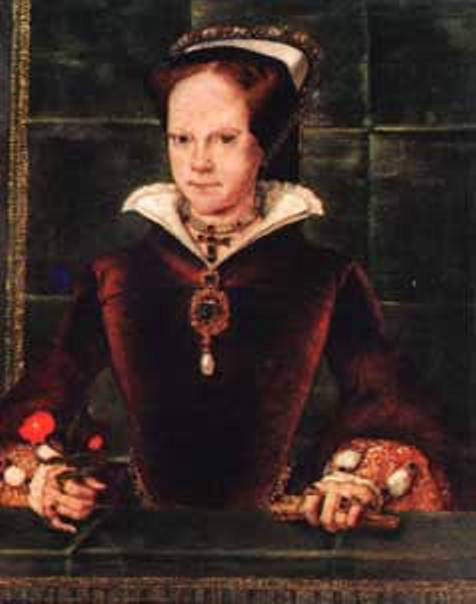
Queen Mary I (Bloody Mary) wearing the La Peregrina Pearl as a pendant to a brooch
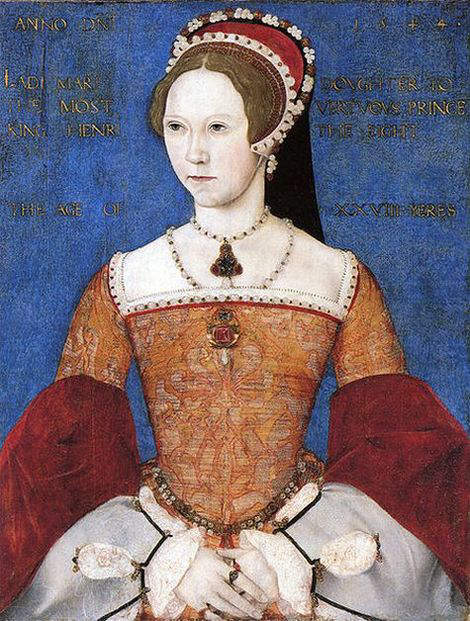
1544-portrait of Mary I by Master John showing her wearing a brooch set with colored stones and the La Peregrina hanging as a pendant
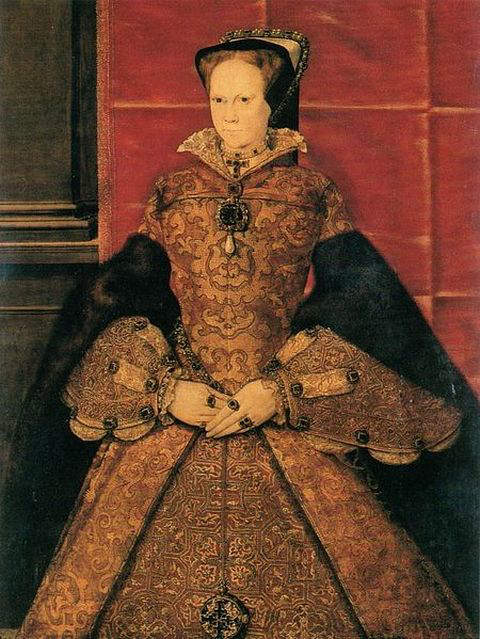
1554-portrait of Mary I by Hans Eworth, showing her wearing a brooch with the La Peregrina hanging as a pendant
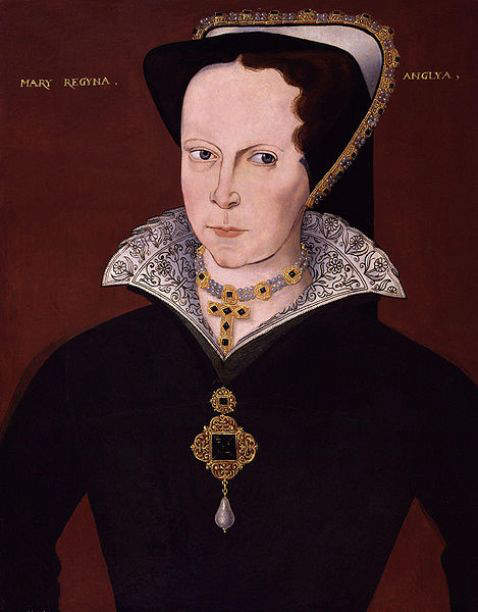
Portrait of Mary I by unknown artist circa 1555, showing her wearing a pendant-brooch, with the La Peregrina as the pendant
Queen Mary earns the infamous name "Bloody Mary"
Queen Mary I has gone down in history as the first queen to rule England in her own right. A popular queen who ascended the throne with the goodwill of the people, eventually turned out to become one of the most unpopular monarchs in the history of England, and acquired the most infamous name of "Bloody Mary." This was due to her inability to adapt herself to the new circumstances in the country, and her fanatic adherence to Roman Catholicism, a religion that had been rejected by her father who founded the Anglican Church. Queen Mary emboldened by her success in defeating a Protestant insurrection against her in 1554, just before she married Philip II of Spain, restored Catholicism as the state religion, and revived the laws against heresy. For the next three years, heretics were relentlessly executed, and around 300 were burned alive at the stake. Mary and her Spanish husband were hated and distrusted, and she was held responsible for all the slaughter carried out in the name of religion. She then acquired the infamous name "Bloody Mary." However, Queen Mary did not live long. In the fifth year of her rule, in 1558, she died, bringing a great sense of relief to her subjects who suffered under her rule.
The La Peregrina pearl is returned to Spain after Queen Mary's death
After the death of Queen Mary, the "La Peregrina" pearl was returned to Spain, and once again entered the Crown Jewels of Spain. The renowned pearl remained in the crown treasury for the next 250 years, and became a favorite ornament of most of the queen consorts, until the year 1808, when Spain was captured by Napoleon, who installed his brother, Joseph Bonaparte on the Spanish throne. Evidence for the use of the "La Peregrina" pearl by the wives of Philip III (1598-1621) and Philip IV (1621-1665) of Spain, Margaret of Austria and Isabel (Elizabeth) of France respectively, are seen in the famous 17th century Velazquez paintings, two separate portraits of the queens on horseback, each wearing the La Peregrina pearl. It appears that both Philip III and Philip IV also used the celebrated pearl as a hat ornament, as depicted by an equestrian portrait of Philip III circa 1635, by Diego Velazquez. Philip IV was a poet and patron of the arts and a friend of the painter Velazquez; and most of his paintings portray Philip and the members of his court. In 1660, the pearl gained attention at King Louis XIV's court in France, when King Philip IV of Spain wore it as a hat ornament at the wedding of his daughter Marie Therese to King Louis XIV.
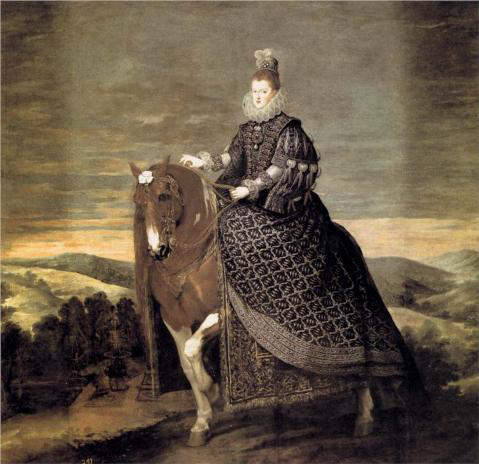
1635 Equestrian portrait of Margaret of Austria, Queen consort of King Philip III of Spain, by Diego Velazquez, depict her wearing a brooch with the La Peregrina pearl as a pendant

Equestrian portrait of Philip III, circa 1635, by Diego Velazquez, depicting him wearing the La Peregrina as a hat ornament
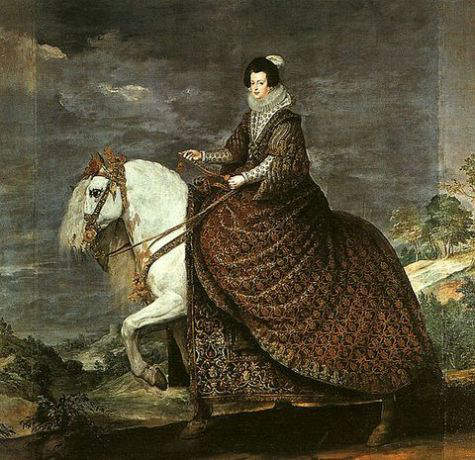
Equestrian portrait of Queen Isabel, consort of King Philip IV of Spain, by Diego Velazquez circa 1634-35, depicts her wearing a brooch with the La Peregrina Pearl as a pendant.
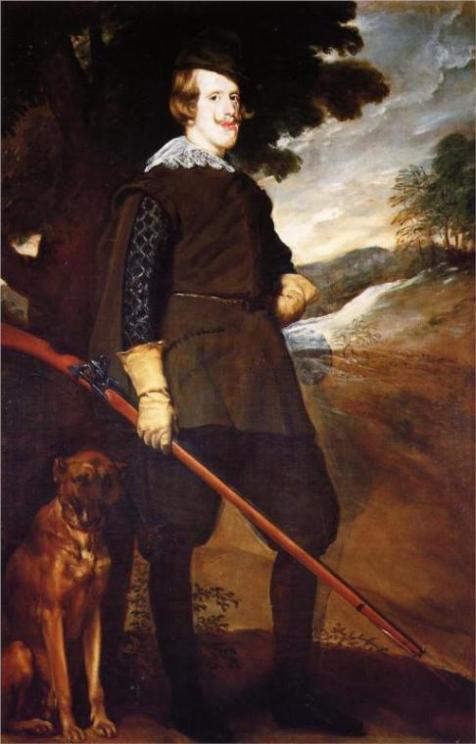
Philip IV, King of Spain - Portrait by Diego Velazquez in 1632
The La Peregrina Pearl comes into the possession of Joseph Bonaparte in 1808
Napoleon Bonaparte installs his elder brother Joseph Bonaparte as ruler of Spain
Spain had remained an ally of Napoleon Bonaparte during his military campaigns, and co-operated with him in the invasion of Portugal in 1807. The position taken by Spain was more due to its weak military position rather than being a matter of choice. Around this time in-fighting between supporters of King Charles IV and his son and heir-apparent Ferdinand VII had reached a new height, and Charles IV was forced to abdicate in favor of his son Ferdinand VII; and the unpopular prime minister Godoy was dismissed from his post. Napoleon saw this as a golden opportunity to intervene directly in the affairs of Spain and rid Europe of its last Bourbon rulers. He summoned both Charles IV and his son Ferdinand VII, to Bayonne in April 1808 and forced them to abdicate and interned them in Talleyrand's Chateau. Napoleon then offered the Spanish throne to his elder brother Joseph Bonaparte, which became a highly unpopular move, and led to the organization of an underground resistance movement against French occupation in Spain. An uprising against the French in May 1802 in Madrid was violently suppressed, but was successful in other parts of Spain where French military power was weak. Then in July 1808, the Spanish regular troops defeated an inferior and poorly equipped French army at a battle in Baylen, forcing Joseph Bonaparte to retreat hastily from Madrid. Angered by this humiliation Napoleon himself led an attack on Spain in 1808, inflicting defeat after defeat on the inferior Spanish forces, capturing the entire peninsula within a short period and restoring Joseph Bonaparte to the Spanish throne in Madrid by the end of 1808.
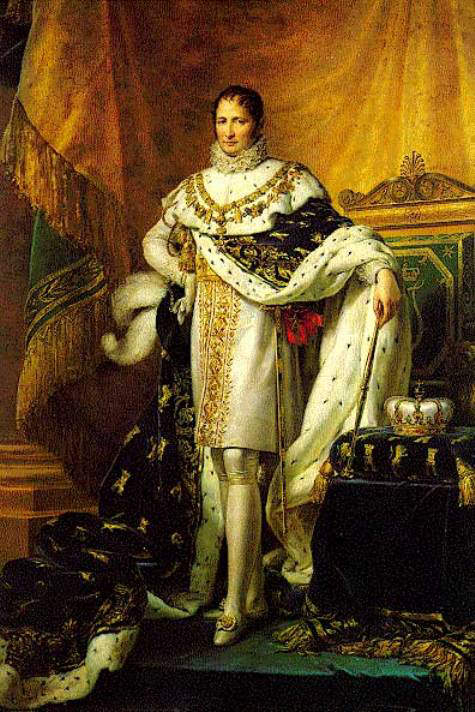
Joseph Bonaparte, elder brother of Napoleon Bonaparte
Napoleon's forces are defeated in the battle of Vitoria in 1813, and withdraw from Spain. Joseph Bonaparte carries the La Peregrina pearl to France
Joseph Bonaparte then ruled Spain for the next five years until 1813. The Iberian Peninsula, with the Portugal and Spanish resistance fighters fighting the occupation of the French forces, became a bridgehead in Europe for the British forces led by the duke of Wellington, to attack Napoleon's forces. The Anglo-Spanish-Portuguese combined forces under the command of the duke of Wellington achieved decisive successes and in 1813, at the battle of Vitoria a combined Anglo-Spanish-Portuguese army of 72,000 troops led by the Duke of Wellington, defeated a French army of 57,000 troops, led by Joseph Bonaparte, thus gaining control of the Basque provinces of Spain, and eventually causing the French forces to retreat over the Pyrennes and back into France.
When Joseph Bonaparte left Spain after reigning for five years, it is said that he carried part of the Spanish Crown Jewels with him that also included the "La Peregrina Pearl."
Joseph Bonaparte leaves the La Peregrina Pearl to his nephew Charles Louis Napoleon
Joseph Bonaparte goes into exile in the U.S. but later moves to Florence where he dies in 1844
After the final fall of Napoleon Bonaparte in 1815, Joseph Bonaparte emigrated to the United States where he took up permanent residence. He later visited England, and for a time resided in Genoa, from where he moved to Florence. He died in Florence in 1844. At the time he died he left the "La Peregrina Pearl" and other important items of jewelry to his nephew Charles Louis Bonaparte, the son of his brother Louis Bonaparte.
Charles Louis Bonaparte (future Napoleon III) - his childhood and youth in exile
Charles Louis Bonaparte was the third son of Napoleon's brother Louis Bonaparte, who was the King of Holland from 1806 - 1810, and his wife Hortense de Beauharnais, stepdaughter of Napoleon I. Charles Louis Bonaparte's childhood and youth were mostly spent in exile, after his mother Hortense de Beauharnais was banished from France in 1815 after the fall of Napoleon. She first settled in Switzerland where she purchased a castle. Charles Louis attended grammar school in Augsburg, Germany, but was later taught at home by private tutors. He was inspired by his mother about his lost fatherland and an admiration of the genius of Napoleon Bonaparte. In 1832, after the death of his cousin the Duke of Reichstadt, the only son of Napoleon Bonaparte, he considered himself as the legitimate claimant to the French throne. He then underwent military training and also pursued studies in economics and social problems. He then published his own writings on political and military subjects, and expressed the view that only an emperor could give France both glory and liberty.
Charles Louis Bonaparte - his attempts to regain his uncle's throne, and exile in the U.S. and Britain
In October, 1836, he attempted a coup d'etat against King Louis-Philippe, who exiled him to the United States. He returned to Switzerland in the following year during his mother's last illness. After being expelled from Switzerland in 1838, he settled in England. While in England he published several writings trying to transform Bonapartism into a political ideology. In 1840, he landed near Boulogne, France, with 56 of his followers, and attempted to win over the town's garrison, but failed. He was arrested, brought to trial, and sent to permanent confinement in a fortress, from which he escaped in 1846, and fled back to England. During the republican revolts of 1848 against the monarchies of Europe, he traveled to Paris, but was again deported by the provisional government, but his supporters organized a Bonapartist party and presented him as their candidate for the Constituent Assembly. The party made considerable gains in the June and September elections.
Charles Louis Bonaparte returns to France and runs for the presidency of the second republic
Charles Louis Bonaparte then arrived in Paris, and began preparations to run for presidency, and was supported by the adherents of the Bourbons, Louis-Philippe and Catholics. Charles Louis Bonaparte promised his voters to bring back the glorious days of the Napoleonic era, and was duly elected as president obtaining almost 5.5 million votes.
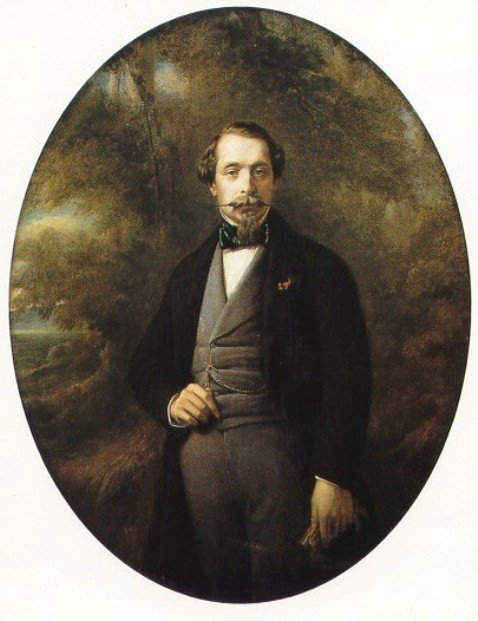
Emperor Napoleon III
After his first 4-year term in office, Charles Louis Bonaparte holds a plebiscite and becomes the Emperor of France, as Napoleon III
After a successful 4 years in office, he was not eligible for a second term in office according to the constitution. He then engineered a coup d'etat, dissolving the legislative assembly and decreeing a new constitution, which was approved by a plebiscite. A second plebiscite held in November 1852, confirmed him as the emperor of France as Napoleon III. In 1853 he married countess Eugenie de Montijo. He continued his authoritarian rule until 1870, and during his two decades of rule gave France prosperity and a stable government. Finally in the Franco-German war of 1870-71, he was defeated and surrendered to the Germans. After, being released by the Germans he went to live in England with his wife Empress Eugenie. He died in 1873, at the age of 65 years, after undergoing surgery for the removal of bladder stones.
Charles Louis Bonaparte sells the La Peregrina Pearl to the 2nd Marquis of Abercorn
During his exile in England, Charles Louis Bonaparte is believed to have sold the "La Peregrina Pearl" to Lord James Hamilton, the 2nd Marquess of Abercorn, at a time of grave financial difficulties. This sale must have taken place before his arrival in France in 1848 to contest the presidential elections, while Lord Hamilton was still the 2nd Marquess of Abercorn. In the year 1868, Lord Hamilton was created the first Duke of Abercorn.
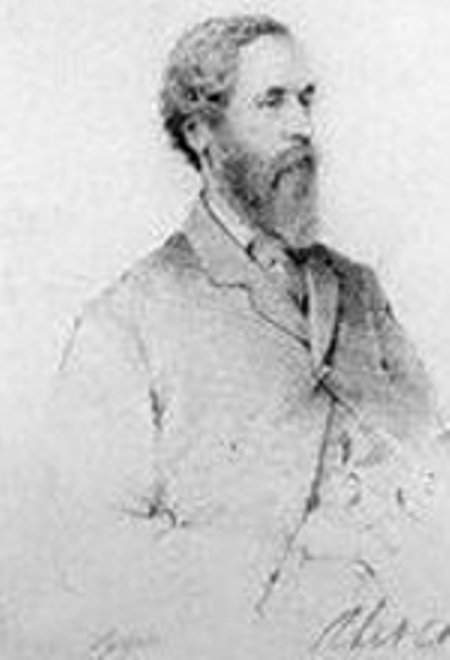
James Hamilton - First Duke of Abercorn
Lord James Hamilton, the 2nd Marquess of Abercorn, was born in Mayfair, London, on January 21, 1811, and was the son of James Hamilton, Viscount Hamilton, who died when his son was only three years old. Hamilton who was educated at Harrow and Christ Church, Oxford, succeeded his grandfather as the 2nd Marquess of Abercorn in 1818. In the year 1832, he married Lady Louisa Russell, the daughter of the 6th Duke of Bedford, John Russel. The couple were blessed with fourteen children, thirteen of whom survived infancy. Other titles bestowed on him, and posts held during his life time were :-
1) Knight of the Garter in 1844
2) Lord Lieutenant of County Donegal
3) Privy Counsellor
5) Groom of the Stole to Prince Albert
6) Viceroy of Ireland in 1866
7) The 1st Duke of Abercorn in 1868
8) Marquess of Hamilton
9) Envoy extra-ordinary for the investiture of King Umberto I of Italy
10) Chancellor of the University of Ireland
The La Peregrina Pearl is lost at least on two formal occasions but recovered soon after
Lord James Hamilton gave the pearl set on a necklace to his wife, who used it for formal occasions in the Buckingham Palace. On one such occasion Lady Louisa Jane Russel (Lady Hamilton) discovered to her utter dismay that the "La Peregrina Pearl" was missing from the setting in her necklace. Fortunately, however the lost pearl was spotted on the velvety folds of the train of another lady going into dinner. She again lost it on a second occasion at Windsor Castle, but fortunately this time too it was recovered from the upholstery of a sofa. Lady Jane Hamilton gave the historic pearl to her son the 2nd Duke of Abercorn, who had it drilled and securely fastened to its setting.
The La Peregrina Pearl remains in the Hamilton family up to 1969, and comes up for auction at Sotheby's in London. Richard Burton purchases the pearl as a Valentine's gift for Elizabeth Taylor
The La Peregrina Pearl purchased by the 2nd Marquess of Abercorn remained in the Abercorn family for over a hundred years, and finally assigned to the House of Sotheby's in London for auction in 1969, and was purchased by Richard Burton for $ 37,000 as a Valentine's gift for Elizabeth Taylor.
Burton lavished extraordinary jewelry on Elizabeth Taylor, throughout their relationship. His attachment to his wife at one time was so intense that he is reported to have said " I cannot see life without Elizabeth . She is my everything - my breath, my blood, my mind and my imagination." The jewelry gifts given by Burton, was not only spectacular, but pieces with real history and provenance.
The La Peregrina Pearl he purchased has a history of nearly 500 years and has passed through the aritocratic families of Spain, France and Britain. Among the other renowned pieces of jewelry he purchased included the Krupp diamond once owned by Vera Krupp, the second wife of the steel magnate Alfred Krupp, the 69.68-carat, pear-shaped, G-color diamond, which came to be known as the Taylor-Burton diamond, a Bulgari pendant set in platinum with an 18.61-carat emerald surrounded by diamonds, and the 17th-century heart-shaped Taj Mahal diamond, given to her on her 40th birthday in 1972. " I would have liked to buy her the Taj Mahal itself," Burton remarked, " but it would cost too much to transport."

Middle-aged Elizabeth Taylor wearing the La Peregrina Necklace and a matching pair of pearl eardrops.
In her book "My Love Affair with Jewelry," Elizabeth Taylor wrote of her delight in receiving the amazing gift, the La Peregrina, and the panic and horror when it went missing soon after. To her greatest relief the La Peregrina was safely retrieved from the mouth of one of her pet dogs. She wrote that it took her a week to sum up the courage to tell Burton of the mishap !

A later photograph of Elizabeth Taylor wearing the La Peregrina Necklace and a pair of pearl drop earrings
At the time Burton purchased the "La Peregrina" it was suspended as a pendant to a delicate pearl linked necklace, which did not suit their taste. Therefore they decided to have the necklace re-designed using the expertise of Cartier. The result was the masterpiece shown above consisting of pearls, rubies and diamonds.
The La Peregrina Pearl Necklace comes up for auction at Christie's New York, on Dec 13, 2011, as part of the sale of the magnificent collection of jewels that once belonged to Elizabeth Taylor
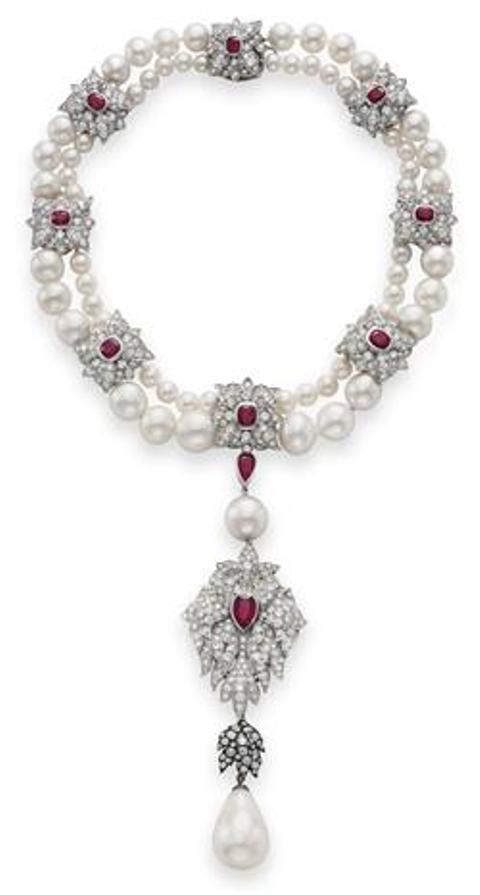
The La Peregrina - A natural pearl, diamond, ruby and cultured pearl necklace from Christie's auction catalogue
© Christie's
The La Peregrina Pearl Necklace is due to come up for sale, at a Christie's New York auction, to be held at the New York Rockefeller Plaza, on December 13 and 14, 2011, as part of the sale of the magnificent collection of jewels, that once belonged to the legendary Hollywood actress Dame Elizabeth Taylor. Out of the 269 jewels in the collection, 80 of Elizabeth Taylor's most iconic jewels, including historic pieces such as the La Peregrina Pearl and Necklace, the Krupp diamond, and the Taj Mahal diamond, will come up on the first day of the sale, December 13, 2011, at a special Legendary Jewels Evening Sale. The remaining 189 pieces will be put up for sale on the following day, December 14, 2011, during two day-sale sessions. La Peregrina Pearl necklace has been allotted Lot No. 12 in the auction catalogue and has been titled "La Peregrina, a Natural Pearl, Diamond, Ruby and Cultured Pearl Necklace, by Cartier.
The La Peregrina Pearl is accompanied by a report, bearing No. 59574, dated May 19, 2011, issued by the Swiss Gemmological Institute, confirming the authenticity of this saltwater natural pearl, and an additional letter from the same institute, describing the unique rarity and exceptional historic provenance of the La Peregrina.
Another report bearing No. 59572, also issued by the Swiss Gemmological Institute, and dated May 19, 2011 confirm the authenticity of the 57 saltwater natural pearls, in the two-strand necklace, and the identity of the remaining 4 beaded saltwater cultured pearls.
Historic provenance associated with the La Peregrina will undoubtedly enhance the final price realized at the auction
A pre-sale estimate of $2,000,000 to $3,000,000 has been placed on the La Peregrina Pearl and the two-strand necklace. However, the historic provenance of the La Peregrina Pearl, with a recorded history of over 500 years - passing through the royal families of Spain, England and France, and finally owned by a noble family of England for almost 120 years, before it was purchased at a Sotheby's auction in London, in 1969, by Richard Burton, who gave it as a Valentine Day gift to Elizabeth Taylor - would certainly enhance the final price realized at the auction, which might be at least twice the upper pre-sale estimate. It has been observed in the past, that historic provenance associated with jewelry pieces, always enhances the final price realized at auctions, sometimes even two to three folds of the upper estimate.
You are welcome to discuss this post/related topics with Dr Shihaan and other experts from around the world in our FORUMS (forums.internetstones.com)
Back to Famous Diamonds,Gemstones and Pearls
Related :-
References :-
1.Here There and Everywhere - Lord Frederic Hamilton, M.D. Plunkett
2.The History of Peregrina - www.earthlink.net
3.From Satan's Crown to the Holy Grail - Diane Morgan
4.Legendary Pearls, legendary tales - www.thejewelryhut.com
5.James Hamilton - 1st Duke of Abercorn - From Wikipedia, the free encyclopedia
6.Duke of Abercorn - From Wikipedia, the free encyclopedia.
7.Encyclopaedia Britannica - 2006
8.Stories about famous precious stones - Mrs Goddard Orpen
Powered by Ultra Secure
Amazon (USA) Cloud Network

Founder Internet Stones.COM
Register in our Forums
| Featured In
|
|
|
|
|
|
|
|

